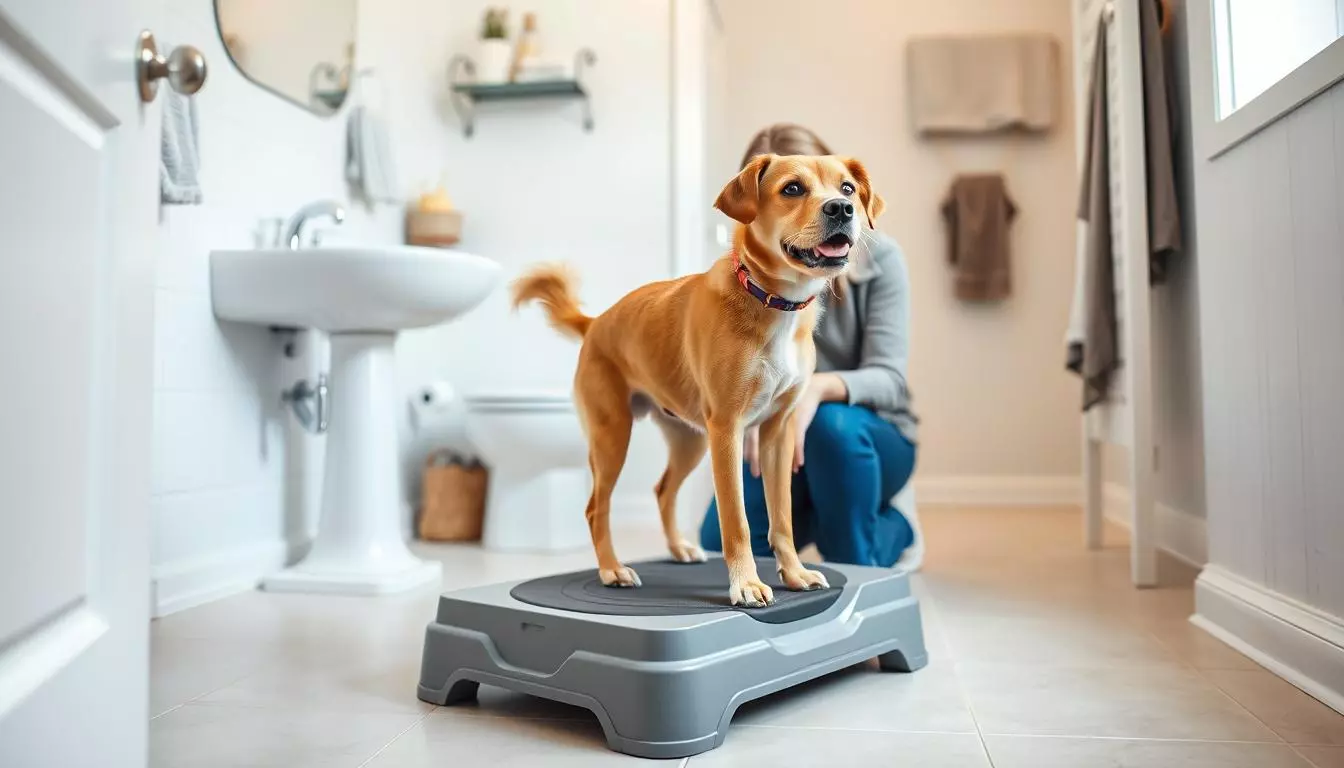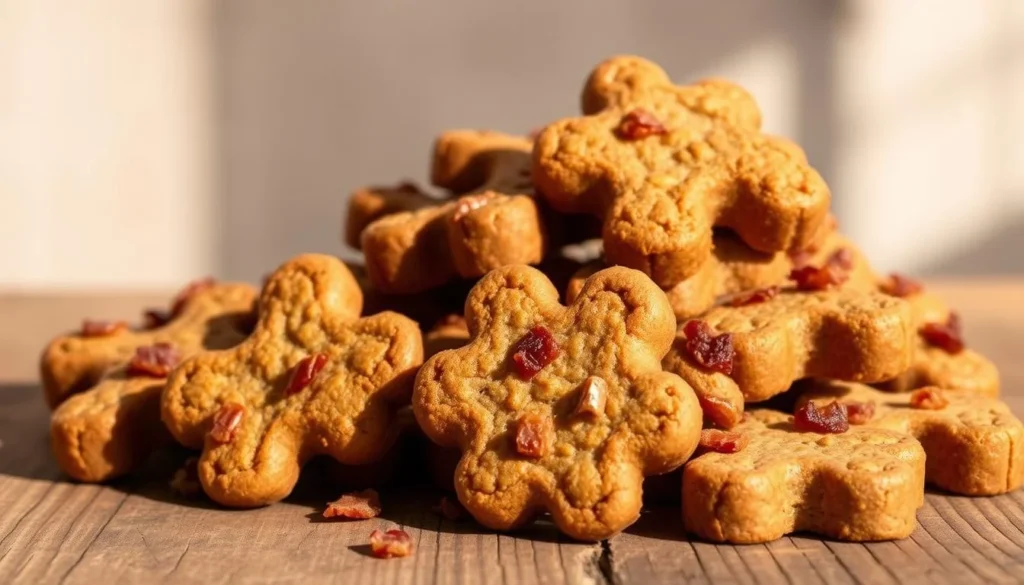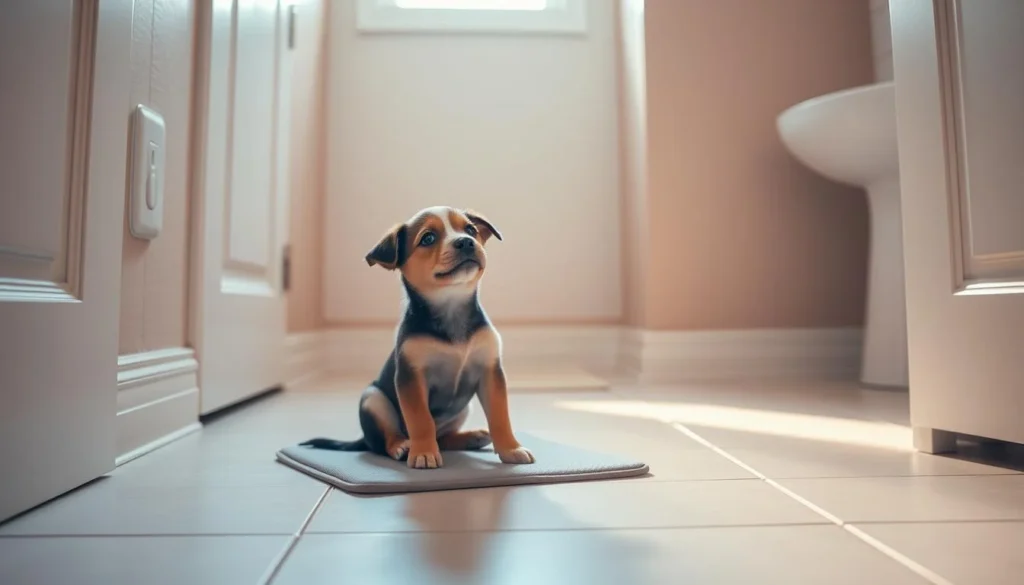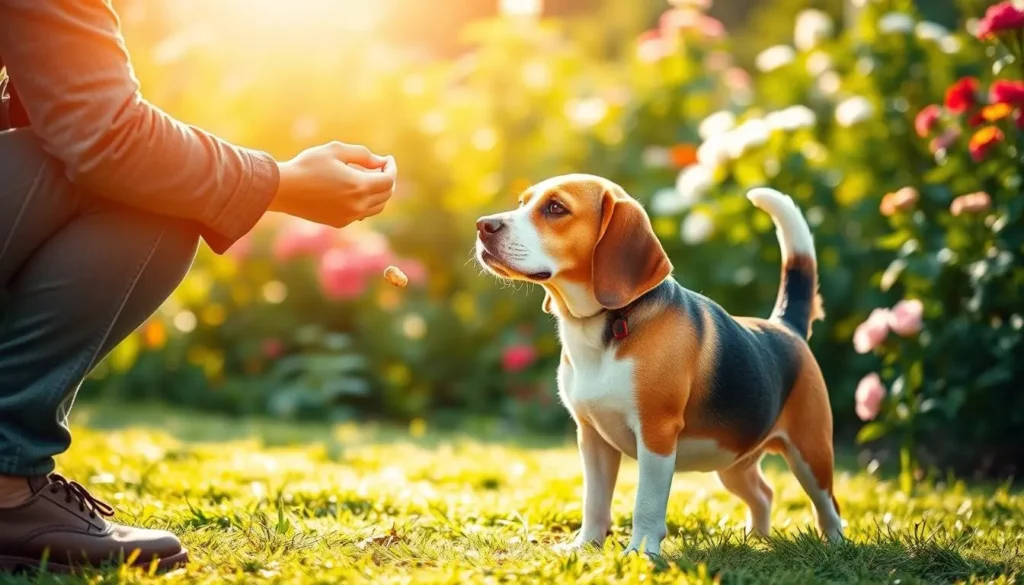Bringing a new dog into my home was a joy. But, potty training soon became a challenge. I felt overwhelmed, wondering how to teach dog toilet training and how long it would take.
With persistence and the right strategies, I found success in potty training. This guide will help you through each step. It offers practical tips on potty training and building a strong bond with your dog. By following these steps, you'll create a harmonious home for you and your dog.
Key Takeaways
- Understanding canine instincts is crucial for effective potty training.
- Establishing a consistent routine can streamline the process.
- Positive reinforcement is key to teaching your dog proper behavior.
- Being patient and observant helps recognize your dog's unique needs.
- Managing accidents appropriately can prevent long-term issues.
- Long-term maintenance of good potty habits is essential for success.
The Importance of Potty Training Your Dog
Potty training is key to keeping your home clean and healthy. A dog that isn't trained can damage your furniture and leave bad smells. It helps build trust and communication with your dog, making your bond stronger.
Good potty training does more than keep your home clean. It makes your dog's life better because they know where to go. This is good for their mind and helps avoid bad behavior.
But, bad potty training can lead to big problems. Dogs that soil the house might get rehomed or abandoned. It's important to start good habits early. When potty training works, you and your dog can enjoy each other's company without accidents.
Understanding Your Dog's Bathroom Habits
Knowing how your dog goes to the bathroom is key to potty training. Each dog is different, based on their age, size, and health. For example, puppies need to go more often because their bladders are small.
It's important to watch for signs like sniffing, circling, or whining. These signs mean your dog needs to go. Quick action helps in training.
Here’s a summary of some normal potty behavior in dogs:
| Behavior | Meaning |
|---|---|
| Sniffing | Searching for a suitable spot to eliminate |
| Circling | Preparing to go to the bathroom |
| Whining | Expressing discomfort or urgency to go out |
| Pacing | Indicating that they need to relieve themselves soon |
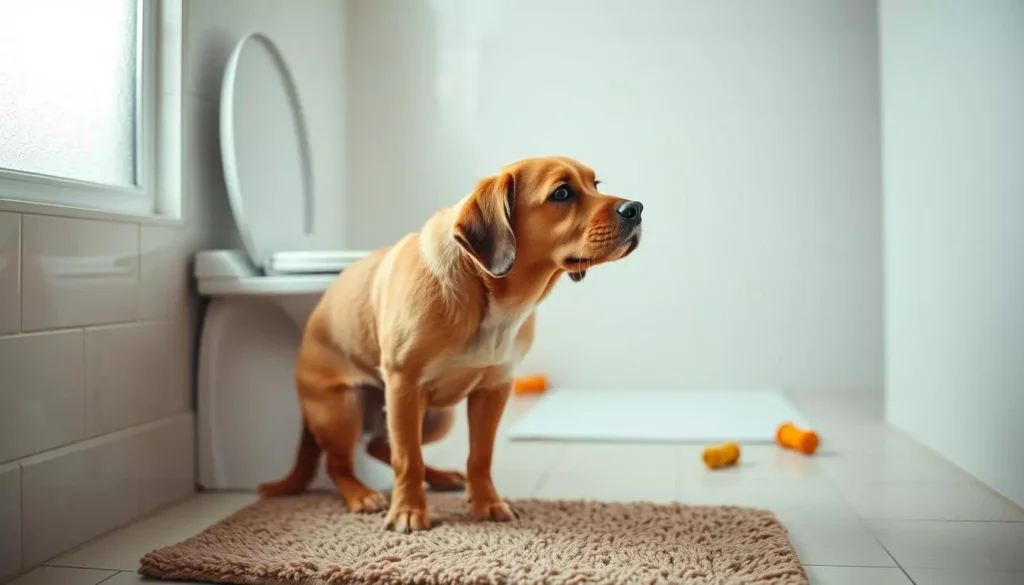
By watching these signs, you can understand your dog's habits better. This helps in successful potty training. Keeping an eye on these behaviors helps create a good training space.
Preparing for Potty Training
Getting ready for potty training a dog is key. A good plan makes the process smooth and effective. I start by setting up a consistent feeding schedule. This helps my dog's bathroom habits and makes training easier.
Choosing a special potty area is also crucial. I pick a spot that's easy for my dog to get to but not where they play. This helps them learn where to go. Keeping the area safe and distraction-free helps them learn better.
Having the right tools is important too. I need training pads, waste bags, and treats. These make training fun and efficient for both of us. A well-structured and supportive environment helps my dog learn faster.
| Preparation Step | Description |
|---|---|
| Consistent Feeding Schedule | Helps regulate bathroom habits |
| Designated Potty Area | Provides a clear and appropriate space for elimination |
| Necessary Tools | Includes training pads, waste bags, and rewards to aid the process |
| Structured Environment | Reduces distractions and facilitates understanding |
Establishing a Potty Training Schedule
Creating a potty training schedule is key for successful dog training. I watch my dog's habits to find the best routine. Puppies need to go often, so I take them out every couple of hours.
I also take them out after meals, naps, or playtime. This helps them learn when it's time to go.
Consistency is crucial in potty training. A set schedule helps my dog know when to go. It makes them feel secure and builds good habits.
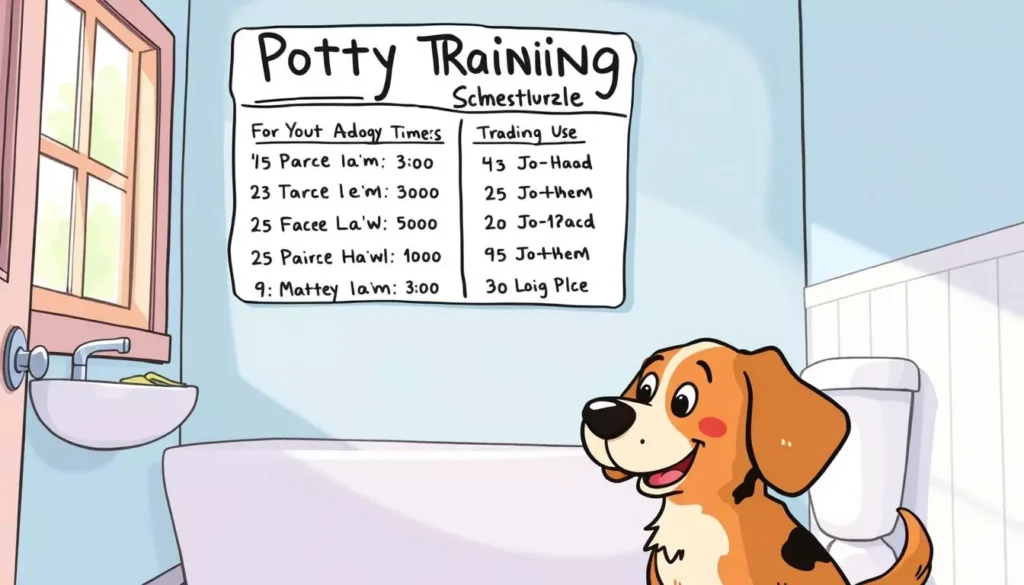
Creating a Designated Potty Area
Setting up a specific potty area for dogs is key to successful potty training. It helps my dog learn where to go. This spot can be indoors with puppy pads or outdoors, based on our living situation and my dog's needs.
Being consistent is crucial. I always take my dog to the same spot. This avoids confusion and creates a routine. Using verbal cues helps my dog connect that spot with potty time, making training more effective.
Having a specific potty location helps my dog understand where to go. This makes training smoother and reduces accidents at home. By using these strategies, my dog's potty habits improve, making our home life better.
How to Teach Dog Toilet Training
Teaching dog toilet training is all about using the right methods. One top strategy is using rewards to encourage good behavior. This makes my dog understand that going potty in the right spot is a positive thing. Being consistent is crucial for this method to succeed.
Using Positive Reinforcement Techniques
When my dog goes potty where they should, I reward them right away. I use treats, praise, or excitement to show them it's good. This teaches my dog that going potty in the right place is something to be proud of.
As time goes on, my dog learns to connect going potty with getting a reward. This encourages them to do it again.
Verbal Cues to Encourage Elimination
Verbal cues are also key in dog toilet training. Phrases like "go potty" help my dog understand what to do. I use these cues every time we go for a potty break.
This helps my dog learn to go potty when I say the command. It's an important part of teaching them.
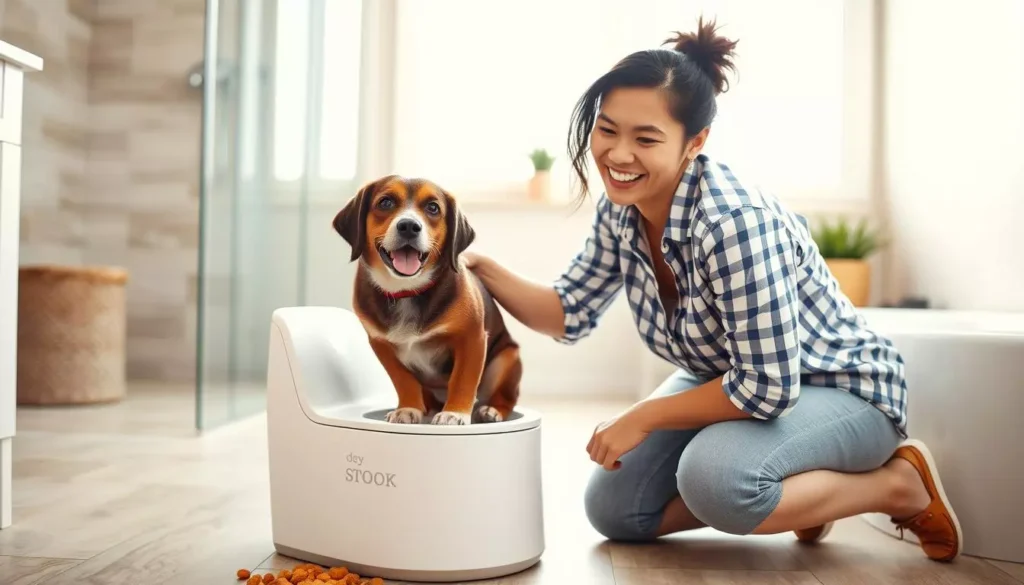
Monitoring and Observing Your Dog
To ensure successful potty training, it's key to supervise your dog well. I keep a close eye on my dog, watching their behavior closely. This helps me spot when they need to go outside.
Signs that your dog needs to potty can be different. They might circle, sniff, or whine. Catching these signs early helps my dog learn when to go outside.
Having a routine helps me notice these signs better. It makes understanding my dog's body language easier. Being attentive makes potty training a positive experience for both of us.
Managing Accidents: What to Do
Accidents are a normal part of potty training. It's important to stay calm when they happen. Instead of punishing, I use a strategy that helps my dog learn.
First, I clean up the mess with enzymatic cleaners. These products break down waste and remove bad smells. This helps prevent accidents in the same spot. Following these steps makes training more successful.
Cleaning Up Accidents Effectively
Here are some best practices for cleaning dog messes:
- Always blot, do not wipe. This method absorbs the mess without spreading it.
- Choose an enzymatic cleaner specifically designed for pet messes. This type of cleaner targets odors and stains effectively.
- Clean the area thoroughly, allowing the solution to sit for the recommended time. This ensures the enzymes can break down the mess.
- Rinse the area well with water to remove any residue from the cleaner.
After cleaning, I redirect my dog to the potty area. This reinforces good behavior. It supports learning and keeps the environment calm. By using these methods, I help with potty training without stressing my dog.
Dealing with Common Potty Training Challenges
Potty training is both rewarding and challenging. I've faced many common issues, like regression. This can happen due to stress, changes in routine, or environmental factors. It's key to know what triggers these problems.
Understanding Potty Training Regression
Several reasons can cause potty training regression. Stressful events, like moving or adding a new family member, can affect my dog's behavior. Changes in my routine, like going back to work, can also cause setbacks. Spotting these triggers helps me tackle them.
To beat setbacks, I go back to the basics. I spend more time watching my dog and rewarding good behavior. Keeping a steady potty training schedule makes my dog feel secure. Being patient and reassuring helps build good habits.
| Trigger | Impact | Solution |
|---|---|---|
| Stress | Increased accidents, reluctance to go outside | Provide a calm environment and extra reassurance |
| Routine Change | Confusion over potty times | Stick to a consistent schedule |
| New Environment | Frequent accidents in unfamiliar spaces | Gradually introduce the new area |
Potty Training Tools and Aids
Choosing the right tools is key for dog potty training. Specific tools help create a good learning environment. Crates are great, teaching dogs to wait until they're outside. Dogs naturally want to keep their sleeping area clean.
Puppy pads are essential, especially for apartment dwellers or those away for long periods. They give a place for dogs to go potty indoors, cutting down on accidents. Training sprays make certain spots more appealing for dogs to go.
Knowing the right aids for potty training is important. The right mix of crates, puppy pads, and sprays meets my dog's needs. Here's a look at some popular tools:
| Tool | Purpose | Benefits |
|---|---|---|
| Crates | Teaches cleanliness | Helps prevent accidents indoors |
| Puppy Pads | Indoor urination spot | Protects floors and reduces mess |
| Training Sprays | Attracts dogs to specific areas | Encourages designated potty spots |
Using these tools makes potty training easier. The right tools support my dog's needs and make our home happier.
Tips for Working Owners: Potty Training When You’re Away
Potty training can be tough for pet owners with busy jobs. It's key to make sure your pet gets to go outside when they need to. Using a pet sitter or dog walker helps a lot. They keep your pet happy and trained while you're away.
Finding a Pet Sitter or Dog Walker
Long work hours mean I need someone reliable to help with my pet. A good pet sitter or dog walker keeps my pet happy and healthy. Here's how I find the right person:
- Ask friends or other pet owners for recommendations.
- Look online for pet care services and read reviews.
- Meet with potential sitters or walkers to talk about my pet's needs.
- Teach them how to keep up with my pet's training.
Good communication is key. It makes sure my pet gets the same training even when I'm not there. This helps a lot with potty training while at work and keeps my dog happy and healthy.
Maintaining Good Potty Habits Long-Term
Keeping up good potty habits takes a lot of work. It's key to keep up the good work after your dog learns to use the potty. I use positive methods to keep my dog's habits strong. Things like treats and praise help a lot.
It's important to keep up regular potty breaks. A set schedule helps my dog know when it's time to go. But, life can change and sometimes my dog might forget. I watch for any signs of trouble and fix it fast.
To keep good habits going, I use different strategies. Here's what I do:
- Keep using positive rewards for good potty behavior.
- Watch for my dog's signals and adjust the schedule as needed.
- Check if any changes in the environment upset my dog.
- Look out for any signs of bad habits and fix them right away.
With hard work and patience, my dog stays on track with potty training. This makes our home a happy and healthy place.
Conclusion
As we finish this guide on dog toilet training, let's think about what we've learned. Teaching your dog to use the bathroom is crucial. It keeps your home clean and makes your dog happy and healthy. Being consistent, patient, and positive is key.
Teaching dogs is something every owner can do with the right approach. Remember, every dog is unique and learns at their own pace. By setting a routine and using the right spot for potty, many problems can be solved.
Putting effort into potty training is essential for a good bond with your dog. I suggest using the tips from this article. They can help you and your dog live happily and cleanly together.

